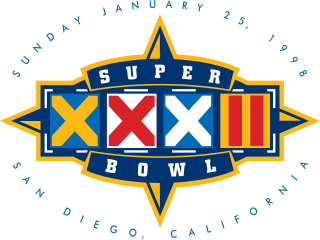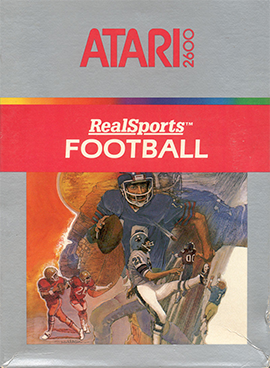
The quarterback, colloquially known as the "signal caller", is a position in gridiron football. Quarterbacks are members of the offensive platoon and mostly line up directly behind the offensive line. In modern American football, the quarterback is usually considered the leader of the offense, and is often responsible for calling the play in the huddle. The quarterback also touches the ball on almost every offensive play, and is almost always the offensive player that throws forward passes. When the QB is tackled behind the line of scrimmage, it is called a sack.

Super Bowl XXXII was an American football game played between the National Football Conference (NFC) champion and defending Super Bowl XXXI champion Green Bay Packers and the American Football Conference (AFC) champion Denver Broncos to decide the National Football League (NFL) champion for the 1997 season. The Broncos defeated the Packers by the score of 31–24. The game was played on January 25, 1998, at Qualcomm Stadium in San Diego, California, the second time that the Super Bowl was held in that city. Super Bowl XXXII also made Qualcomm Stadium the only stadium in history to host both the Super Bowl and the World Series in the same year.

A running back (RB) is a member of the offensive backfield in gridiron football. The primary roles of a running back are to receive handoffs from the quarterback to rush the ball, to line up as a receiver to catch the ball, and block. There are usually one or two running backs on the field for a given play, depending on the offensive formation. A running back may be a halfback, a wingback or a fullback. A running back will sometimes be called a "feature back" if he is the team's starting running back.

A cornerback (CB) is a member of the defensive backfield or secondary in gridiron football. Cornerbacks cover receivers most of the time, but also blitz and defend against such offensive running plays as sweeps and reverses. They create turnovers through hard tackles, interceptions, and deflecting forward passes.
The West Coast offense is an offense in American football that places a greater emphasis on passing than on running.
The hurry-up offense is an American football offensive style, which has two different but related forms in which the offensive team avoids delays between plays. The hurry-up, no-huddle offense (HUNH) refers to avoiding or shortening the huddle to limit or disrupt defensive strategies and flexibility. The two-minute drill is a clock-management strategy that may limit huddles but also emphasizes plays that stop the game clock. While the two-minute drill refers to parts of the game with little time remaining on the game clock, the no-huddle may be used in some form at any time. The no-huddle offense was pioneered by the Cincinnati Bengals and reached its most famous and complete usage by the Buffalo Bills, nicknamed the "K-Gun", during the 1990s under head coach Marv Levy and offensive coordinator Ted Marchibroda. Coach Gus Malzahn was known for helping popularize this offense style of combining both the hurry-up and no-huddle offenses, publishing a book called The Hurry-Up, No Huddle: An Offensive Philosophy (2003). He helped pioneer and popularize it at the high school and collegiate levels through his success with the style.
Strategy forms a major part of American football. Both teams plan many aspects of their plays (offense) and response to plays (defense), such as what formations they take, who they put on the field, and the roles and instructions each player are given. Throughout a game, each team adapts to the other's apparent strengths and weaknesses, trying various approaches to outmaneuver or overpower their opponent in order to win the game.On offense your job on the field is to score you can do that by scoring a touchdown by advancing the ball into the end zone either by running the ball or passing it another way to score is by field goal which is worth three points.Your job on defense is to prevent the other team from scoring and from gaining ground this way they get as little points as possible

Cyberball is a video game released in arcades in 1988 by Atari Games. The game is a 7-man American football using robotic avatars of different speeds, sizes, and skill sets set in the year 2022. Originally released for arcades, Cyberball was ported to several home consoles and computers.

The 46 defense is an American football defensive formation, an eight men in the box defense, with six players along the line of scrimmage. There are two players at linebacker depth playing linebacker technique, and then three defensive backs. The 46 defense was originally developed and popularized with the Chicago Bears by their defensive coordinator Buddy Ryan, who later became head coach of the Philadelphia Eagles and Arizona Cardinals.
The halfback option play is an unorthodox play in American and Canadian football. It resembles a normal running play, but the running back has the option to throw a pass to another eligible receiver before crossing the line of scrimmage.

RealSports Football is a 1982 American football video game made by Atari, Inc. for the Atari 2600. Versions for the Atari 5200 and Atari 8-bit family followed in 1983. It is part of the RealSports series of games.

In American football, the specific role that a player takes on the field is referred to as their "position". Under the modern rules of American football, both teams are allowed 11 players on the field at one time and have "unlimited free substitutions", meaning that they may change any number of players during any "dead ball" situation. This has resulted in the development of three task-specific "platoons" of players within any single team: the offense, the defense, and the so-called 'special teams'. Within these three separate "platoons", various positions exist depending on the jobs that the players are doing.

The flexbone formation is an offensive formation in American football that includes a quarterback, five offensive linemen, three running backs, and varying numbers of tight ends and wide receivers. The flexbone formation is a predominant turnover formation derived from the wishbone formation and it features a quarterback under center with a fullback lined up directly behind the quarterback. There are two smaller running backs called slotbacks aligned behind the line of scrimmage on each side of the offensive line. The slotbacks are sometimes incorrectly referred to as wingbacks. But in order to be a wingback, there must be a guard, tackle and tight end all on one side of the center on the line of scrimmage and then the wingback off the line of scrimmage.

Quarterback is a one- or two-player American football arcade game released by Leland in 1987.

The spread offense is an offensive scheme in gridiron football that typically places the quarterback in the shotgun formation, and "spreads" the defense horizontally using three-, four-, and even five-receiver sets. Used at every level of the game including professional, college, and high school programs across the US and Canada, spread offenses often employ a no-huddle approach. Some implementations of the spread also feature wide splits between the offensive linemen.
The A-11 offense is an offensive scheme that has been used in some levels of amateur American football. In this offense, a loophole in the rules governing kicking formations is used to disguise which offensive players would be eligible to receive a pass for any given play. It was designed by Kurt Bryan and Steve Humphries of Piedmont High School in California.
The following terms are used in American football, both conventional and indoor. Some of these terms are also in use in Canadian football; for a list of terms unique to that code, see Glossary of Canadian football.
A play calling system in American football is the specific language and methods used to call offensive plays.

NFL Football is a sports video game developed by Mattel and released for its Intellivision video game system in 1979. The players each control a football team competing in a standard four-quarter game. Like Mattel's other sports video games, NFL Football did not use any official National Football League team names or player names, even though Mattel obtained a license from the NFL and used the league's logo in its box art. NFL Football has been cited as the first football video game to have a playbook.












